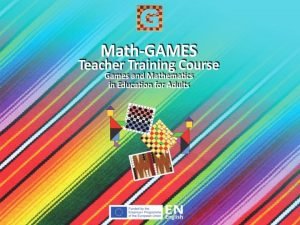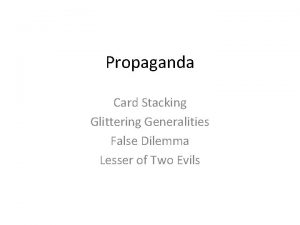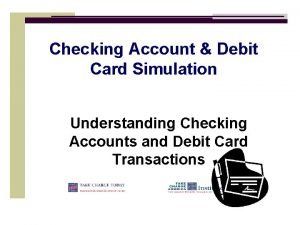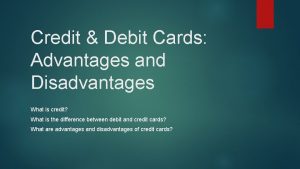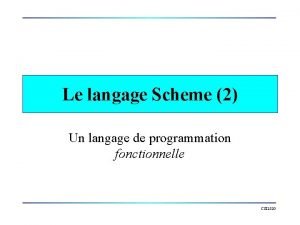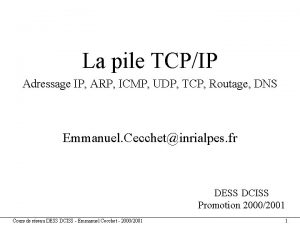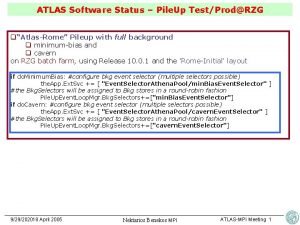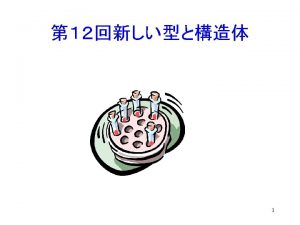7 3 Steal the Pile Card Game Aims








- Slides: 8


7. 3 Steal the Pile (Card Game) Aims: • Participants should be taught to count reliably up to 40. Partecipants learn: • to order and compare numbers up to 40. • Add single-digit numbers with totals to 10. • Develop easy strategy skills sort and classify objects using a single criterion. • Understand probability. • Identify the range of possible outcome when using a card • Determine the approach, materials and strategies. • Develop the mental calculation abilities

7. 3 Steal the Pile (Card Game) Comments on the Course: • Lesson takes 45 Minutes, give a deck of cards for each 2 - 4 players. • Prepare copies from the worksheet for each participant, following the instructions. • You can start the lesson explaining how to play “Steal the Pile”. • Build up groups with 3 or 5 persons: 2 or 4 are playing; one more is watching the game. • The participants play several times the game “Steal the Pile”. This makes them feel self-confident. • The participants learn to count up to 40 and recognize the cards and their value. • They learn how to calculate with subitizing small amounts through the cards, add and remove a quantity using the subitizing. • They learn to use strategy to add from the major number • They learn that the mental calculation is strategic and flexible; it is guided by the estimation of the possible result.

7. 3 Steal the Pile (Card Game) Hints • At the end of the lesson the worksheet has to be completed. • If the participants cannot read, you haveto guide them. • If participants have difficulties to count or do the subitizing, they have to train – they need more time. • If participants have difficulties to count, you have to divide the lesson into two lessons: First lesson: play and count by mind, second lesson: play and learn the subitizing. • Following lesson: Look for another game, in which the participants have to count up to 10


7. 3 Steal the Pile (Card Game) Start the game showing the 40 cards and the different suit marks. Count the 40 cards one by one until they have learnt the numbers. Order them in a line according to the increasing value from 1 up to the king (10) Make the participants recognize all the numbers in the different suit marks and that the highest value is 10! Show them the three main figures and their own value. King=10 Horse=9 Infantry-man=8 Then describe the difference between the two cards that you see on your left The second one has one more cup in the middle: they are a 6 and a 7 Now explain: if you have on the table seven and two and you hold in your hand a horse can you take all the cards because 7 + 2 is 9 and the horse value is 9 If you have in your hand two 4 and one 7 and on the table are 7 and 6 don’t play 7, but 4. If my opponent has a 4 too, and takes mine, you will steal the pile with your second 4.

7. 3 Steal the Pile (Card Game) Play the game • • The participants play the game “Steal the pile” with open cards. You can guide them in the phases of the game: Each player picks up his hand compares the cards he is holding, with those on the table, looking for matches You support the identification of the ordered configuration of the objects in the cards, connecting them to the corresponding amount. This can facilitate the calculation skills (subitizing). In this case, for example, the teachers will focus on the position of the elements (cups). They are in 2 lines and it is easy to memorize the number 6. In the second card, it compares one more not linedup element. It means that it is enough to add 1 to the memorized card (+1). Adding numbers The player can take more cards, where the sum is the same number he holds. In this case he has to add the numbers of the cards on the table (see Math-GAMES Compendium). Counting The player counts the items using his fingers. Later the player learns to count starting directly from the major number.

The result is: Play Games and learn Mathematics more easily. Our Project-Website will help you: www. math-games. eu
